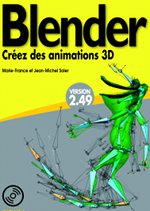|

(This page wouldn't be there without the
help and explanations of Eric Huchet alias Huric, who is the forum
master of news://news. newz.net/nzn.fr.3D, and who has produced the pictures
accompanying this page as well as the example file. I hope I haven't betrayed
his tought. )
When you're constructing the lighting of
a 3D scene, unless you are using a radiosity module, you do not have to
think like in the real life, it's a mistake.
We can - we must -
place a light source hidden by a wall or any else object and use
the
appropriate distance to obtain the desired effects. The process
may appear strange. However this is a particularity of the omnidirectional
lighting in scan line
rendering type. For these sources no shadows are cast on the other objects
of the scene (we will see later on how the shadow can and must be simulated).
Moreover, nothing stop the luminous ray, only the opposite faces of the
polygons are shaded.
| At the end, we finally must conclude that
the lighting of an interior scene through the exterior is the best system
that we have to simulate a radiosity effect and we can even extend this
principal to any kind of 3D lighting.
In lighting the opposite wall through the
exterior we can precisely control the spreading of light on the surface.
Explanation ... |
oooooooooooooooooooooooo
o
o
o
o
o
X--->
o
o
o
o
o
oooooooooooooooooooooooo |
If we locate the luminous source symbolized
through "X" in the interior of the scene, we can be sure to obtain "stains"
of light and a "bad distribution" of the light like the one here after
: |

|
| Here, of course, the effect is deliberately
emphasized.
This is due to the fact that the light
source is too close of the wall and the way the luminous intensity is calculated
: depending on the angle with the lighted surface. When the source is too
close, the fluctuation of the angle is very hard, which produces a not
very regular lighting.
Moving the source away from the lighted
surface, and even moving it out of the scene ... we obtain a less important
angle fluctuation, and thus a more regular spreading of light on the lighted
surface.
|
oooooooooooooooooooooooo
o
o
o
o
X-----o---------------------->
o
o
o
o
o
oooooooooooooooooooooooo |
|
Radiance of the wall
|

|
 |
|
Red exterior light source parameters
|
Light reflected by objects
Putting light sources in the interior of
an object is also a manner to approach as close as possible of the realistic
rendering. In this case a light of the "Sphere" type allows to control
the intensity since this one is inversely proportional to the distance
of the centre .
|
|
Radiance of the blue sphere
|
 |
 |
|
The Blue sphere light source parameters
|
The dropped shadows
Obviously it is necessary to add a projector
(Spot) to obtain dropped shadows.
However there is always a more dense shadow
area. To obtain this effect we add a negative light that, as it's
name indicates it, produces darkness.
|
|
contact shadow
|
 |
 |
|
Negative light parameters
|
Dropped Shadows can be entirely simulated
with negative light. You can test this effect in the here attached
file. |

Les questions concernant cette page
peuvent être posées sur :
news://news.zoo-logique.org/3D.Blender
|










